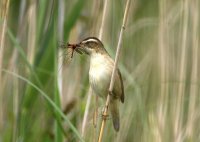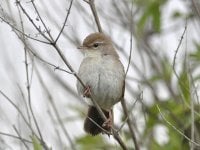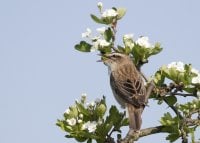There have been numerous papers published using CES data. The following represents a small selection of those.
'Continental' Effort Scheme: exploring climate change impacts at a European scale
Fourteen of the 15 warmest years have occurred since 2000 and 2014 was officially the warmest globally. As global temperatures have increased, many species distributions have exhibited polewards shifts, a trend that is predicted to continue in future decades. However, the mechanisms underlying such shifts are not well understood.
Here we quantify the impact of large-scale variation in temperature on reproductive output within a group of migratory birds to assess the potential for future range changes. We use data from captures of 350,000 individual birds, collected under constant effort ringing protocols from 1994–2006 (from Britain & Ireland, Catalonia, France and the Netherlands), to estimate productivity (percentage of juveniles caught) for seven species of migrant warblers (family Sylviidae) breeding in Europe in relation to spring temperature and latitude by fitting generalized linear mixed models. Productivity was highest at mid-latitudes for six of our seven study species and did not change significantly over the study period. Only one species (Reed Warbler, Acrocephalus scirpaceus) showed increased productivity at northern sites as expected. Six of the seven species also showed evidence for local adaptation, with productivity decreasing as temperatures diverged from the local mean. However, for three of these species the ‘optimum’ temperature was greater than the local mean temperature at the majority of sites. These results indicate that latitudinal gradients in productivity are likely to influence large-scale abundance patterns, but that adaptation to local climate conditions has the potential to constrain the rate of northward range shifts in many species.
Eglington, S.M., Julliard, R., Gargallo, G., van der Jeugd, H.J., Pearce-Higgins, J.W., Baillie, S.R. & Robinson, R.A. (In press) Latitudinal gradients in the productivity of European migrant warblers have not shifted northwards during a period of climate change. Global Ecology & Biogeography doi:10.1111/geb.12267.
Local habitat changes on Constant Effort Sites
A mist?netting site at Cow Lane Gravel Pits, Cambridgeshire, contributes to the British Trust for Ornithology's (BTO) Constant Effort Site (CES) ringing scheme. Standard net sites are located in relatively stable osier scrub Salix, but the nearby habitat is subject to rapid change which has resulted from the restoration of a gravel pit. This study addresses the question of whether this local habitat change results in fluctuations in the CES catch at Cow Lane which deviate from the national trends. CES catches of passerines in mist?nets from 1989 to 1996 at Cow Lane are compared to the national trends as identified by the BTO. Most species have experienced increases and decreases at Cow Lane in accordance with the national trends, and appear to be relatively insensitive to local habitat changes. Sedge Warblers Acrocephalus schoenobaenus and Reed Warblers A. scirpaceus are the notable exceptions. Mist netting with additional nets in the adjacent habitat suggests that these species are responding to local expansion of wetland vegetation, and changes in the catch reflect localised changes in habitat use.
Harrison, N.M., Whitehouse, M.J., Prince, P.A. & Huin, N. (2000) What problems do local habitat changes represent for the Constant Effort Site ringing scheme? Ringing & Migration 20: 1-8. Full article available from Taylor & Francis.
Cetti's Warbler: an anatomy of an expanding population
The study demonstrated how constant effort (CE) ringing can be used to estimate productivity of breeding populations, using the expanding Cetti's Warbler Cettia cetti population as an example. A logistic generalized linear model was developed from an established method of estimating abundance to generate an annual index of productivity from CE catches. Dispersal of birds from ring–recapture data was modelled using a simple exponential model of dispersal. We found that the number of Cetti's Warblers on CE sites has increased markedly, particularly since 1998, but productivity has remained largely constant. The rate of population increase has slowed in recent years, in part because of an increasing sensitivity of the population to cold winters. Juveniles disperse further than adults, and the distance over which they disperse has increased. CE catching provides a way of easily measuring whole-season productivity. The future of Cetti's Warblers in Britain looks secure, but the population may be approaching its maximum size under current conditions.
Robinson, R.A., Freeman, S.N., Balmer, D.E. & Grantham, M.J. (2007) Cetti’s Warbler: anatomy of an expanding population. Bird Study 54: 230-235.
An integrated population model from constant-effort bird ringing data
Data from the British Trust for Ornithology’s Constant Effort Sites scheme, an annual bird-ringing programme in which catch effort is standardised, are routinely used to index abundance, productivity and adult survival. Efficient models have been developed for each. Such a monitoring scheme, based on ringing across a number of sites, is perhaps unique in providing this combination of demographic information and makes the data particularly amenable to an integrated approach to population modelling. We develop a Bayesian approach and a deterministic population model uniting abundance, productivity and survival. The method is applied to Constant Effort Site data for Sedge Warblers Acrocephalus schoenobaenus. The possibility of “transient” birds needs to be incorporated within the model and we demonstrate how the current methodology can be efficiently extended to use data from multiple recaptures within individual years.
Cave, V.M., King, R. & Freeman, S.N. (2010) An integrated population model from constant-effort bird ringing data. Journal of Agricultural, Biological and Environmental Statistics 15: 119-137. Download the PDF.



